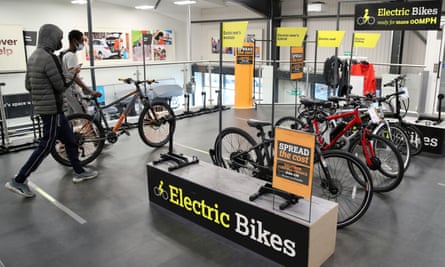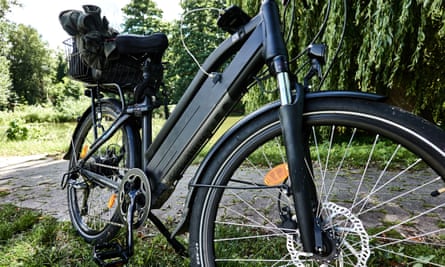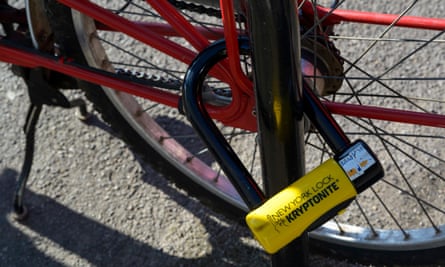Power ahead in 2021: how to buy an electric bike
Lesley Willis from Alton, Hampshire can barely contain her glee about the electric bike she bought a year ago for just under £1,000. She is 76 and says she feels liberated: “I now sail up the hills. It’s absolutely glorious.”
After just a few months she convinced her husband, James, to buy one too. He paid extra for a bike with a longer range, and their friends are now joining them.
“In our age range, as a way of keeping people who are 65-plus fit and active, I think it’s brilliant,” says Willis. Her only regret – and a mild one at that – has been the distance she can go on her battery, as the power runs out after just 15 miles. So she has invested in another battery she can carry on the bike to double the distance she can travel.
I feel liberated – I now sail up the hills. It’s absolutely gloriousLesley Willis, e-bike owner
The Willises are typical of many electric bike buyers in the UK – madly enthusiastic after buying them, keen to spread the word and often upgrading to longer-range bikes after their first purchase.
It’s not just about older cyclists needing assistance going up hills. In the Netherlands, famous for its lack of hills, e-bikes make up more than 40% of all cycle sales. Shoppers, commuters and young mountain bikers are as likely to buy electric bikes as older cyclists.
If you are thinking of joining the e-bikers here’s what you need to know before you take the plunge.
How fast you’ll go
By law, electric bikes are restricted to 15.5mph (25kph) in the UK – which is really no more than a road cyclist will manage on the flat. You have to pedal for the motor to kick in – you don’t just press a button and sit back. You can go faster than 15.5mph; it’s just that after this speed the motor assistance will cut out. Generally e-bikes come with eco, tour, sport and turbo modes. Click into turbo and you’ll rocket away when the traffic light goes green, but drain your battery just as fast.
The price
The cheapest models in Halfords sell for £599; in Decathlon they start at £699. But with these you’ll run out of power after just 20 miles. The average price people pay is between £1,000 and £1,500, says Halfords. This will get you a bike offering a range of about 40-50 miles, while £1,500-plus takes you into 60-80 mile territory. The cheapest at online bike store Wiggle is £1,200, with models running up to £6,000. What you pay largely depends on the battery power and the type and position of the motor.
 View image in fullscreenHalfords says the average price people pay for an e-bike is between £1,000 and £1,500. Photograph: Peter Cziborra/Reuters
View image in fullscreenHalfords says the average price people pay for an e-bike is between £1,000 and £1,500. Photograph: Peter Cziborra/Reuters
How to pay less
If you buy through your employer’s Cycle to Work scheme, you can save 32% to 42% of the total cost of the bike and accessories. It doesn’t matter if the bike is electric or conventional, and the old £1,000 spending limit has been removed. It is a salary sacrifice scheme where you buy the bike out of your gross income, so before income tax and national insurance have been deducted. You are free to buy whatever bike you choose at almost any bike shop in the country.
In Scotland you can save even more
If you are resident in the country you can apply for a loan of up to £6,000 for each household to buy an electric bike. The loan has to be repaid over four years but there is no interest charged on the money borrowed. Details can be found at energysavingtrust.org.uk.
What about batteries?
Battery packs, mostly now lithium-ion, vary between 250Wh and 500Wh, and the size will determine how far you can go on one charge and how much assistance the motor will give you. The exact range depends on variables such as your weight and the terrain but if you intend to use the bike for longer journeys then buy the biggest battery you can afford.
Make sure the battery is replaceable in quality as it will become less efficient after three to five years. Generally a lithium-ion battery should last at least 500-1,000 recharges, but replacing it can be very pricey. For example, a Bosch 500Wh power pack costs £600. That’s the price of a good standard road bike in itself. You will want to remove it when leaving the bike in risky areas, as the batteries are attractive to thieves even if the frame is securely locked.
Look for the position of the motor
E-bikes can have their motor fitted on the front wheel hub, the back wheel or in the mid-part of the bike. Cheaper models tend to have front-mounted motors, which is not ideal as the motor is powering your steering wheel. A rear motor feels more natural and is softer on the chain. Centre-drive motors are regarded as best for balance and ride, but tend to be more expensive.
 View image in fullscreenSome e-bikes have their motor mounted on the rear hub. Photograph: Frank Heinz/Alamy
View image in fullscreenSome e-bikes have their motor mounted on the rear hub. Photograph: Frank Heinz/Alamy
Beware of the weight
You can’t get away from the fact that e-bikes, while a joy to ride, are heavy. Typically they weigh about 20-25kg, which is a good 10kg more than a conventional road bike. Loading them on to cars or a train requires a bit of muscle.
Punctures
E-bikes are no more prone to punctures than conventional bikes. But if the motor is fitted to the wheel hub, it can be tricky to replace the tube.
Popular bikes
Retailers still persist in labelling bikes as “men’s” or “women’s” models, although the step-through frame is fast becoming the unisex standard.
Below are what is on offer from some of the big national retailers but try to support your local independent retailer.
 View image in fullscreenSome people ordered e-bikes online during the coronavirus lockdown so they could avoid public transport. Photograph: Kay Roxby/Alamy
View image in fullscreenSome people ordered e-bikes online during the coronavirus lockdown so they could avoid public transport. Photograph: Kay Roxby/Alamy
Halfords: Among its bestselling models are the Carrera Subway men’s hybrid bike, with a 60-mile range at £1,099, and the Pendleton Somerby hybrid (listed under women’s bikes) at £999 offering a 50-mile range.
Decathlon: Its bestseller is the Riverside hybrid bike, which costs £999 and promises 31 to 53 miles depending on the mode used.
Wiggle: Bestsellers include the Cube Reaction hybrid at £2,499, which has a Bosch 625 power tube that in eco-mode could take you 150 miles. The Superior eRX 630 urban e-bike is a more budget-friendly £1,199.
‘Every time I ride it, I get the same thrill’: how I fell in love with my e-bike
 View image in fullscreenPatrick Collinson bought his £2,250 Raleigh e-bike with the aim of using it for long-distance trips. Photograph: Neil Murphy
View image in fullscreenPatrick Collinson bought his £2,250 Raleigh e-bike with the aim of using it for long-distance trips. Photograph: Neil Murphy
Sometimes you have to accept you are just a stereotype. According to Halfords, the typical e-bike buyer is in their 50s, buys a low step-through, easily accessible model with an upright seating position that offers an extra level of comfort. Well that’s me to a tee. And I love my e-bike.
Six months ago, as the pandemic raged but the spring sun shone, I splashed out on a Raleigh Motus Grand Tourer. Every time I ride it, whether on a short hop or a day going up a mountain, I get the same thrill. They call it the e-bike smile.
It was stupidly expensive. I wanted a bike that could take me, say, the 400 miles on the fabled Lôn Las Cymru route from the top to the bottom of Wales (with overnight stops to re-charge) or the 185-mile Hebridean Way.
So I bought the longest-range, biggest battery bike I could find – the Raleigh promises up to 135 miles on one charge using a Bosch 500Wh battery. The price was £2,250, way more than I first thought I’d spend but I convinced myself other men in their 50s splash out £10,000 on a Harley Davidson. So it was a bargain – sort of.
I convinced myself other men in their 50s splash out £10,000 on a Harley Davidson. So it was a bargain – sort of
Is it worth it? Lockdowns have put travels across Wales and Scotland on the back burner, but I’ve managed plenty of glorious 50- to 60-mile day trips and only once run out of power over the last mile or two. Climbing steep hills requires switching it to sport or turbo mode which will drain the battery much faster than the 135-mile range that a user will only ever achieve in eco mode in perfect conditions. And you really don’t want the battery to drain, as at 25kg it’s a beast of a thing to try cycling uphill without any “assist”.
I’ve only once had a sarcastic remark from a “proper” Lycra-clad cyclist as I glided past him going uphill.
The weight of the bike is the only major downside, especially if you hit some sort of barrier in your route and you have to pick up your bike, like lifting it over a turnstile. I won’t fancy doing that in my 60s or 70s.
Would I recommend my bike to others? Yes, if you really are going to use it for longer-distance cycling. But if I were back to the seven-mile daily cycle commute to the Guardian offices I did for 20 years I’d probably opt for a cheaper, shorter range and definitely lighter model.
Insurance is a bore, as I’ve had to buy a standalone policy for the bike.If I’m shopping in town I’m terrified about it being stolen and even after carefully securing it, I remove the battery and carry it with me, which is another nuisance (it’s nearly 3kg) but you get used to it. The lock was expensive, too.
But these are quibbles. My odometer tells me I’ve done nearly 750 miles even though lockdown has curbed my enthusiasm, at an average speed of 11.7mph (only slightly less than my car manages in the city) and a top speed of 36.3mph. That was downhill and electrically unassisted, of course.
Covering up: how to insure and lock your bike
While most home contents insurance policies will in theory cover bikes, including electric bikes, outside the home for a typical £50-£70 extra premium a year, it is likely that you will end up having to buy a specialist standalone policy.
The problem is that home policies typically offer a maximum of £1,000 to £1,500 for cycles, which just won’t be enough for most e-bike owners.
Don’t automatically dismiss your home insurer. It may allow to you to add a £3,000 bike as a “valuable” item, albeit for a significant extra premium. Before you do this you need to check the excess – the amount that the insurer will deduct from any payout – which in some cases can be as high as £150. Also consider if you want to push up your home insurance premiums for what could be a relatively small claim.
Standalone bike policies tend to be more expensive – and come with long list of stipulations – but if you comply with the terms they should pay out if the worst happens.
One of the key reasons to buy a specialist policy is that they usually offer public liability cover that will protect you in the event you injure someone, or damage property, while riding. E-bikes are faster and heavier than conventional ones, making accidents potentially more serious. Without a policy with this cover, you could be held personally responsible for paying up if someone chooses to sue you for injury or damage.
 View image in fullscreenKryptonite’s New York D-locks are pricey but highly regarded for security. Photograph: DWD-photo/Alamy
View image in fullscreenKryptonite’s New York D-locks are pricey but highly regarded for security. Photograph: DWD-photo/Alamy
Specialist cover for a £1,750 bike will set you back about £100 a year, while £3,000 e-bike cover typically costs around £138 with a first-year discount. Bike insurers include Eversure, CycleSure, Yellow Jersey and Bikmo. The Money.co.uk website is a good starting point as it will do a comparison of the biggest e-bike insurers for you.
However, buyers need to check the small print. For example if the bike is kept in a garage at night does the lock on the door conform to the demands of the policy? Insurers often insist that the bike must be locked to a secure object while left and that the lock used conforms to a minimum standard. You will also need a cable to secure the wheels if they are quick release.
Getting a secure lock for your e-bike is vital. The Cyclist.co.uk website says the best D-lock is the Abus Granit X-Plus 540 (£75), which weighs less than 1.5kg. At a higher price point, Kryptonite’s New York Fahgettaboudit D-lock (£120) is described as offering ultimate security. For those on a budget, the Onguard Pitbull 8005 (£30) is about half the price of rivals and comes with a cable to lock in the wheels.
Miles Brignall




